PRESENTATION
The Practice Guide for intervention in situations of self-neglect was created to offer the latest scientific information to Québec psychosocial intervenors working with self-neglecting persons. This intervention tool is also addressed to all practitioners who intervene with this population and wish to perfect their knowledge of the subject.
It offers guidelines for ideas and action to better detect and intervene in the self-neglect context.
ORIGIN AND EVOLUTION
Self-neglect is a social issue attracting more and more interest from researchers and practitioners (Neesham-Grenon, 2012). However, there is presently no consensus on a definition of self-neglect.
Some consider this behaviour a type of mistreatment. Others, such as the World Health Organisaton, view these as two distinct concepts since self-neglect does not involve a relationship of trust with someone else, a key element in the definition of mistreatment.
In any event, whether the concepts are distinguishable or not, mistreatment and self-neglect are interdependent social issues worthy of attention.
DEVELOPMENT
In 2014, the first edition of the Self-neglect Practice Guide was completed by Jessica Calvé as part of her master’s degree internship in social work. She worked in close collaboration with a team of intervenors in the home-support sector for physically disabled clients at the Eastern Townships Integrated Health and Social Services Center – University of Sherbrooke Geriatrics Institute (CIUSSS de l’Estrie – CHUS)
A second edition of the Intervention in situations of Self-neglect: A Practice Guide is now available. In 2016, this final version was produced thanks to financial assistance from the Research Chair, which is funded by the Québec government’s Secrétariat aux aînés. The guide’s contents were updated and its visual presentation improved. It includes various topics such as:
- Concept of self-neglect
- Characteristics of self-neglecting situations
- Intervening in a context of self-neglect
- Support procedures
- Protective measures
- Elaboration and implementation of an intervention plan
At the end of the guide, there is a diagram highlighting the issues and intervention paths to be considered in situations of self-neglect.
ACCESS TO THE PRACTICE GUIDE
The Self-neglect Practice Guide is available for viewing free-of-charge on the web.
For optimal use of the Practice Guide, the Chair recommends its half-day training program. For more information, contact the Chair by e-mail or telephone at 819-780-2022 Extension 45621.
REFERENCES ASSOCIATED WITH THE PRACTICE GUIDE:
References (in French and English) for the practice guide:
- Calvé, J., & Beaulieu, M. en collaboration avec Caroline Pelletier (2016). L’intervention en contexte d’autonégligence. Guide de pratique. Édition octobre 2016. Chaire de recherche sur la maltraitance envers les personnes aînées. Sherbrooke, 24 p.
- Calvé, J., & Beaulieu, M. in collaboration with Caroline Pelletier (2016). Intervention in Situations of Self-neglect. A Practice Guide. October 2016 Edition. Research Chair on Mistreatment of Older Adults. Sherbrooke, 24 p.
